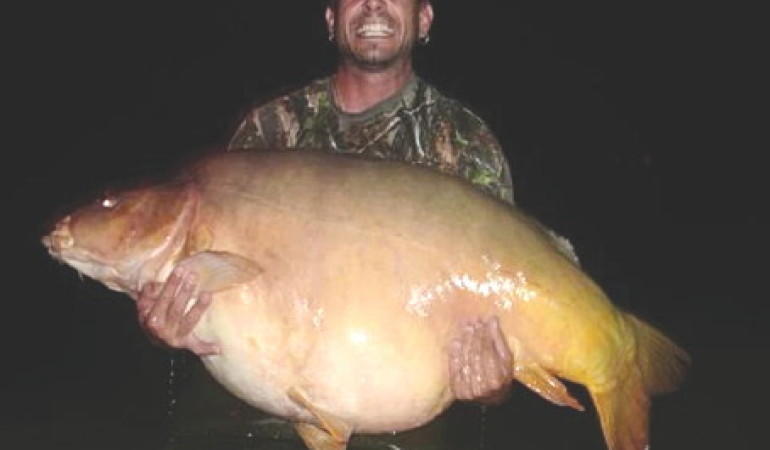Search the Community
Showing results for tags 'carp'.
-

A carp anglers group fishing social
Harry Goodliffe posted a topic in Fishing Minnesota - (Spring, Summer & Fall)
A Carp Anglers Group Fishing social will be on June 23rd in Coon Rapids. If you enter the park from the Coon Rapids side (Egret Blvd), take a left from the parking lot and drive towards the picnic shelters. Take a right at the first stop sign and park in the lot. We will be fishing in the stretch or river behind the picnic shelter/playground. Start time can be before 7am and you can fish into the evening if you want. There will be medals for the 3 largest fish captured.- 1 reply
-
- 2
-

-
- kids
- social event
-
(and 2 more)
Tagged with:
-

Some common misconceptions about carp
Harry Goodliffe posted a topic in Fishing Minnesota - (Spring, Summer & Fall)
Some Common Misconceptions about Carp BY EVAN CARTABIANO - B.S. M.S & MATTHEW HOWARD CARP CAUSE THE TURBIDITY OF THE WATER TO BE HIGH (CARP MAKE THE WATER MUDDY). The answer to this question is that it depends on what the physical characteristics of the water are. In smaller ponds with a silt substrate, Common Carp can cause a noticeable impact on turbidity if high enough concentrations of fish are reached (Barton and Kelton 2000). However, Fletcher et al. (1985) found “no association between high carp densities and high turbidity” in several larger water bodies and concluded that hydrologic changes were to blame and water level fluctuation reduced the amount of water plants, further exacerbating the issue. This would be applicable to many of the larger reservoirs and rivers in the USA. Looking at everything as a whole, Common Carp can cause a increase in turbidity in some systems if that system has a substrate that is conducive to be suspended in the water column. The existence of Common Carp is not the only factor of making the water muddy, and wind and sediment type (Lougheed et al. 1998), as well as boat traffic (Anthony and Downing 2003) are all significant factors that often produce huge effects on water clarity regardless if Common Carp are in the water or not. The effects of boat wakes in particular are striking, with up to a 50% increase in turbidity over up to 56% of the lake (Anthony and Downing 2003). In general, hard substrates such as gravel produce significantly less turbidity than clay or silt (Crivelli, 1983). Another consideration is eutrophication. Eutrophication is an excess in nutrients, especially Nitrogen (N) and Phosphorus (P), in a body of water that ultimately leads to a surge in algal growth. These algal blooms can cause incredibly destructive effects such as increased turbidity and asphyxiation through oxygen crashes. Eutrophication can occur through a variety of sources; human activity is the main source. Run-off water from agricultural land (or lawns) containing fertilizers that are rich in nutrients are a large cause, as well as large urban areas, sewage and industrial discharges (Ansari & Gill, 2013). CARP RUIN THE NESTS OF SPAWNING BASS AND THIS CAUSES A PROBLEM. Do carp eat bass eggs? Wolfe et al. (2009) conducted an experiment in which Largemouth Bass were stocked into a controlled environment, both with and without Common Carp. The results showed that juvenile bass stocked into enclosures containing common carp survived at a higher rate than bass that were stocked without Common Carp. The experiment was then repeated with older juvenile bass and the results were the same. The bass had a higher survivability in the presence of Common Carp. The study also found that during the experiment, Common Carp were observed feeding in the clay bottomed enclosures but egg predation on largemouth bass eggs appeared to be minimal or absent, perhaps as a result of male bass guarding the nests. Male bass also fan the nest with their tails to prevent the accumulation of silt over the eggs (Wolfe et al. 2009). These findings indicate that Largemouth Bass can successfully spawn with Common Carp with little or no negative effects. The findings also indicate that carp pose little or no risk to the survivability of largemouth bass young. CARP EAT ALL OF THE WEED WHICH DAMAGES SPAWNING SITES FOR THE BASS. The impact of Common Carp on aquatic vegetation is varied with some studies finding an no impact (Drenner et al. 1997, Fletcher et al. 1985) and others finding one (Crivelli, 1983). It is worth noting some aspects of Largemouth Bass biology as well. Bass nests are typically found in shallow water in substrates such as sand, soft mud and gravel (Roberge et al. 2001; Moyle 2002; McPhail 2007). Largemouth Bass often nest next to weeds or other structure, but do not nest on weeds. CARP OVERTAKE A WATER CAUSING PROBLEMS WITH OTHER SPECIES. Carp overtaking a water is never a good thing, just like it is never good for Largemouth Bass to take over a water, or Crappie to take over. The result is a stunted population and reduced fish condition, growth rate and maximum size - and poor fishing. How this impacts other species depends on many factors, and which species interaction is examined. While Common Carp do not feed on other fish or fish eggs intentionally, Common Carp can, at high densities, increase the turbidity of the water, at least in shallow silt bottom ponds (Breukelaar 1994; Roberts et al. 1995). This can impair the feeding on sight feeding predators such as Largemouth Bass or Pike and result in decreased growth rate of these species. It is worth noting however that Common Carp eggs are preyed upon by many smaller species (Bajer et al. 2012), which in turn provide food for the predatory species. CONCLUSION: There are a huge number of studies on Common Carp, looking at many aspects of biology, ecology, and cultivation. Many studies conducted in both the USA and Australia have been conducted with the ultimate goal of Common Carp eradication in mind. Like with any other fish species, Common Carp can causes issues in some situations and under these situations management is required. However, under many, perhaps most, situations Common Carp have little or no effect on other species and other factors are the cause of undesirable environmental conditions. The points discussed here are a small part of the topic and are simply a starting point for a larger work that is in progress. Works Cited: Anthony, J. L., & Downing, J. A. (2003). Physical impacts of wind and boat traffic on Clear Lake, Iowa, USA. Lake and Reservoir Management, 19(1), 1-14. Ansari, A., & Gill, S. (2013). Eutrophication: Causes, Consequences and Control, Volume 2. Springer Science & Business Media. Bajer, P. G., Chizinski, C. J., Silbernagel, J. J., & Sorensen, P. W. (2012). Variation in native micro-predator abundance explains recruitment of a mobile invasive fish, the common carp, in a naturally unstable environment. Biological Invasions, 14(9), 1919-1929. Barton, D. R., Kelton, N., & Eedy, R. I. (2000). The effects of carp (Cyprinus carpio L.) on sediment export from a small urban impoundment. Journal of Aquatic Ecosystem Stress and Recovery, 8(2), 155-159. Breukelaar, A. W., Lammens, E. H., Breteler, J. G. K., & Tatrai, I. (1994). Effects of benthivorous bream (Abramis brama) and carp (Cyprinus carpio) on sediment resuspension and concentrations of nutrients and chlorophyll a. Freshwater biology, 32(1), 113-121. Crivelli, A. J. (1983). The destruction of aquatic vegetation by carp. Hydrobiologia, 106(1), 37-41. Drenner, R. W., Gallo, K. L., Edwards, C. M., Rieger, K. E., & Dibble, E. D. (1997). Common carp affect turbidity and angler catch rates of largemouth bass in ponds. North American Journal of Fisheries Management, 17(4), 1010-1013. Fletcher, A. R., Morison, A. K., & Hume, D. J. (1985). Effects of carp, Cyprinus carpio L., on communities of aquatic vegetation and turbidity of waterbodies in the lower Goulburn River basin. Marine and Freshwater Research, 36(3), 311-327. Lougheed, V. L., Crosbie, B., & Chow-Fraser, P. (1998). Predictions on the effect of common carp (Cyprinus carpio) exclusion on water quality, zooplankton, and submergent macrophytes in a Great Lakes wetland. Canadian Journal of Fisheries and Aquatic Sciences, 55(5), 1189-1197. McPhail, J.D. (2007). The Freshwater Fishes of British Columbia. University of Alberta Press. 620 pp. Moyle, P.B. (2002). Inland Fishes of California. Univ. Calif. Press, Los Angeles, Calif. 502pp. Roberge, M. H. M., Slaney, T., & Minns, C. K. (2001). Life History Characteristics of Freshwater Fishes Occurring in British Columbia, with Major Emphasis on Lake Habitat Requirements. Fisheries and Oceans Canada, Marine Environment and Habitat Science Division, Cultus Lake Salmon Research Laboratory. Roberts, J., Chick, A., Oswald, L., & Thompson, P. (1995). Effect of carp, Cyprinus carpio L., an exotic benthivorous fish, on aquatic plants and water quality in experimental ponds. Marine and Freshwater Research, 46(8), 1171-1180. Wolfe, M. D., Santucci, V. J., Einfalt, L. M., & Wahl, D. H. (2009). Effects of common carp on reproduction, growth, and survival of largemouth bass and bluegills. Transactions of the American Fisheries Society, 138(5), 975-983. -
-

Where could i bowfishing within 30 min of maple grove mn
TylerFinney posted a topic in Bowfishing/Spearing - MN
Where could I bowfish within 30 min of maple grove


